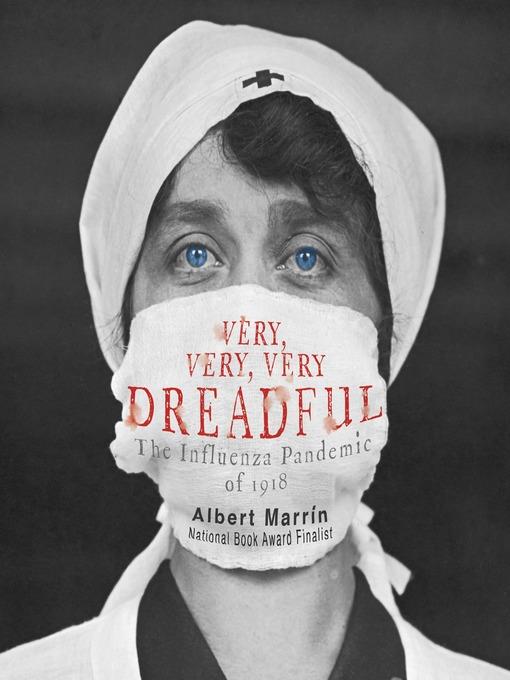
Very, Very, Very Dreadful
The Influenza Pandemic of 1918
فرمت کتاب
ebook
تاریخ انتشار
2018
Lexile Score
1040
Reading Level
6-8
ATOS
8.3
Interest Level
9-12(UG)
نویسنده
Albert Marrinشابک
9781101931486
کتاب های مرتبط
- اطلاعات
- نقد و بررسی
- دیدگاه کاربران
نقد و بررسی

October 15, 2017
A comprehensive history of the influenza pandemic of 1918, the worst global killer that humankind has experienced. Historian Marrin (Uprooted, 2016, etc.) begins four years earlier, at the beginning of World War I. Liberally referencing research, partial statistics, diaries, medical records, newspaper articles, art, photographs, poetry, song, and literature, Marrin works to give an accurate depiction of the circumstances and ill-timed incidents that led to the global catastrophe, which killed at least three times as many people as the war worldwide. The author does not neglect the squalor around the globe: ill soldiers in trenches and overcrowded barracks, suffering families, orphaned children, hunger and undernourishment, and deaths so numerous that bodies are stacked upon bodies. Marrin reveals how scientists and doctors knew little about influenza a century ago, as surgeons and physicians didn't practice routine hygiene or quarantine and were often rendered helpless; in fact, he argues (albeit briefly) that nurses turned out to be most useful against influenza, for they provided supportive care. He then brings the eye-opening narrative to the present, detailing the search for the origins of influenza; recent scientific breakthroughs; the emergence of the H5N1 strain; and how, without intending to, scientists have brought the virus to a risky, imminent pandemic. Not one to shy away from unnerving details, Marrin relays what researchers and scientist express today: another influenza pandemic will unquestionably strike again. (notes, bibliography, further reading, picture credits, index) (Nonfiction. 12-18)
COPYRIGHT(2017) Kirkus Reviews, ALL RIGHTS RESERVED.

November 13, 2017
Marrin (Uprooted) presents a gripping analysis of “history’s worst-ever health disaster,” the so-called Spanish Flu of 1918, which infected 500 million people worldwide (“one-third of the human race at the time”) over an 18-month period. Moving easily through relevant background, from the development of urban centers to contemporary medical practices, he identifies two primary factors: the wretched and overcrowded conditions of WWI battlegrounds, hospitals, and training camps, combined with ignorance of the cause of and best ways to contain influenza. Modern transportation methods, prioritizing war over health, a weakened civilian population, and a virulent mutation of the virus all contributed to the staggering death toll (estimated at between 50 million and 100 million). An engrossing chapter addresses the U.S. response, uncoordinated efforts to combat the pandemic that were often essentially “worthless.” Much of the current understanding of the contagion derives from research done since the 1930s; Marrin’s lucid presentation of it concludes with a sobering assessment of the risks of a similar pandemic, perhaps involving a mutated strain of the H5N1 bird flu virus as “the ultimate terrorist weapon.” Archival photos, notes, and reading suggestions are included. Ages 12–up.

December 1, 2017
Gr 7 Up-Seasoned nonfiction author Marrin returns with a thorough and entertaining telling of the Influenza Pandemic that swept the world during World War I, described as "the greatest medical holocaust in history." The narrative relays the progress of human disease from hunting and gathering days to the rise of "scientific medicine," with a discussion of biological agents from bacteria to viruses. Readers experience the public health crisis from its believed beginning in Kansas through its evolution from outbreak to epidemic to pandemic. The story allows for the wider context of the intertwined fates of the war and the disease, from trenches to overcrowded hospitals. Marrin's story of the flu in his own family (fighting with the Red Army, his father was stricken while stationed in Siberia and survived) adds an interesting personal touch. This anecdote emphasizes a key point: the pandemic was unique in its target population in that it disproportionately affected young adults. Marrin's exhaustive research leaves no topic untouched. The back matter of extensive notes and suggestions for further reading emphasize the meticulous degree of Marrin's research. Pair with Makiia Lucier's A Death-Struck Year for a fictional complement with a personalized perspective. VERDICT A solid nonfiction selection to middle and high school collections that emphasizes history, defense strategy, and medicine.-Deidre Winterhalter, Oak Park Public Library, IL
Copyright 2017 School Library Journal, LLC Used with permission.

Starred review from October 15, 2017
Grades 9-12 *Starred Review* Acclaimed for incisive explorations of America's bleakest moments, from the Triangle Shirtwaist Factory fire (Flesh & Blood So Cheap, 2011) to WWII-era Japanese internment camps (Uprooted, 2016), Marrin homes in on the most deadly disease event in the history of humanity. Raging from early 1918 to mid-1920, the influenza pandemic, aptly dubbed the devil virus, crescendoed in three lethal waves, spanned continents, and claimed an estimated 50- to 100-million lives worldwide. In six riveting chapters, Marrin examines the virus's precursors, including past plagues and prior medical breakthroughs, its aftermath, and its festering backdropthe congested trenches and training camps of WWI. While the pandemic's scope is broad and undiscerning, Marrin's approach is the opposite. With razor-sharp precision, he carefully presents genetic mutations, coffin shortages, the disease's devastating grip on colonized Africa, the direct correlation between women working as nurses and the ratification of the Nineteenth Amendment, and much more. Marrin's conclusion, too, pulls no punches; after all, when it comes to future pandemics, it's not a matter of if one will occur, but when. Fusing hard science and jump-rope rhymes, first-person accounts and crystalline prose, cold reason and breathtaking sensitivity, Marrin crafts an impeccably researched, masterfully told, and downright infectious accountcomplete with lurid black-and-white photos throughout. This is nonfiction at its best.(Reprinted with permission of Booklist, copyright 2017, American Library Association.)

























دیدگاه کاربران